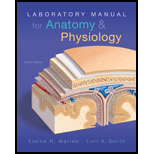
Let’s return to Kyle Boulard, whom we met in the previous chapter. After two days in the hospital, Mr. After two days in the hospital, Kyle Boulard has recovered from his acute diabetic crisis and his type 1 diabetes is once again under control. The last update on his chart before he is discharged includes the following:

BP 150/95, HR 75, temperature
Urine: pH 6.9, negative for glucose and
Mr. Boulard is prescribed a thiazide diuretic and an angiotensin converting enzyme (ACE) inhibitor. He is counseled on the importance of keeping his diabetes under control, taking his medications regularly, and keeping his outpatient follow-up appointments.
Would taking ACE inhibitors and thiazides together have prevented Mr. Boulard’s current symptoms? Explain.
Want to see the full answer?
Check out a sample textbook solution
Chapter 24 Solutions
Laboratory Manual for Anatomy & Physiology (6th Edition) (Anatomy and Physiology)
- Based on the following information, what is the fraction of the drug that is excreted unchanged in the urine? CLR = 11.2 L/hr Dose = 1000 mg AUC, = 27.9 mg/L x hr %3Darrow_forwardState four (4) clinical manifestations of Fluid volume excessarrow_forwardMatch the expected results with the following disorder: Beta-thalassemia. A2 Level RDW Serum Fe [Choose] [Choose] Decreased Normal Elevated [Choose]arrow_forward
- John Smith joined a Triathlon for a cause. The triathlon consisted of a 1.5 km swim, 40 km bike ride and a 10 km run. He was so focused on winning the race. With 6 km left in the run, he felt very weak and light-headed and eventuallly collapsed. He was breathing so fast and was profusely sweating. The Emergency Medical Service on standby rushed to give him medical aid. a.) Discuss the role of electrolytes in this case. b.) What imbalances (Hypernatremia vs. Hyponatremia; Hyperkalemia vs. Hypokalemia) led to his condition? Justify.arrow_forwardQuestion. A 52-year-old turbel man was brought into emergency department by his wife with main complaints of increasing fatigue and weakness. According to his wife his weakness has progressively worsened over the past month. He was so weak that he almost passed out when walking from the entrance of the ed to the registration desk. His wife reported that he has an increased fluid intake and an increase in urinary output. When asked patient reported that there was no pain on urination of history it urinary tract infection. Patient denied chest pain, vision problems, nausea, diarrhoea and syncope. His wife was concerned that the patient was wobbly when he walked. Past medical history Nephrolithiasis Hypertension Benign prostate hypertrophy Medical history Lisinopril Potassium chloride allopurinol diazepam Social history denies alcohol and tobacco use. Vital signs. Blood pressure 107/56 mmhg. Heart rate 115 respiration rate 22 bpm. Temperature 36.9 celcius Physical examination…arrow_forwardCase Study: Kim is a 38-year-old women admitted to the hospital for bulimia. Her laboratory results are as follows: pH 7.48, pCO2 in the normal range, and totalHCO3– higher than normal. Classify her acid-base balance as acidosis or alkalosis, and as metabolic or respiratory. Is there evidence of compensation? Propose the mechanism by which bulimia contributed to the lab results seen.arrow_forward
- Erthy is given an intravenous antibiotic (gentamicin) at a dose of 7 mg/kg per day for a period of 7 days. This dose will be assessed after a week and adjusted accordingly. The gentamicin will be administered in 87 mL of Normal Saline (NS) over a time period of 20 minutes. Please answer the following questions: a. How much will Erthy be getting per day in mg based on this order?b. How much volume of the gentamicin (in mL) should be added to the IV bag; the concentration of gentamicin is 10 mg per mL.arrow_forwardBlood Analysis Glu = 5.0; Na = 145; K = 2.8. Back to patient's chart Glucose Sodium Potassium Calcium Iron Thomas (male) Age: 28 Triage Data complained of abrupt polydipsia (excessive thirst) and polyuria (excessive urine volume, 15 L per day) T3 (triiodothyronine) T4 (thyroxine) 3.9 135 3.5 2.15 Thomas (male) Age: 28 5 0.24 62 Low DII Other Long Description Ca = 2.50 Fe = 27 T3 = 0.33 T4 = 99 glucose urinalysis = 0.0 mmol/L Click here for Report Form Normalarrow_forwardA 44-year-old woman was experiencing headaches and fatigue. The consultingphysician recommended testing glucose and electrolytes. The results are attached in the picture below: (a) What is the difference between serum and plasma? (b) Describe the results (c) Plasma glucose levels lower than 20 mg/dl can be fatal. As the patient’s resultsdid not match with her clinical presentation, the consulting biochemist decidedto investigate this test, and found that the glucose analyser was giving theresults in mM, but the lab assistant had assumed the results were in mg/dl. Isthis error pre-analytical, analytical or post-analytical? (d) 1 mM glucose = 18 mg/dL glucose. What is the patient’s fasting plasmaglucose in mg/dL, and is it within the normal range? (e) Describe possible consequences of this error.arrow_forwardWhich lab values are related to determining the need for acid base balance therapy? Which lab values are may signify the need for a blood transfusion?arrow_forwardWhy is too much Na intake prohibited for people with known heart disease? Please explain in-detailed.arrow_forwardIn order to avoid increased risk of nephrotoxicity to gentamicin, the minimum concentration during the dosing interval should be allowed to decrease below: Group of answer choices 6 mcg/mL The minimum concentration does not matter, the maximum concentration needs to be greater than 20 mcg/mL to avoid increased risk of nephrotoxicity. 3 mcg/mL 2 mcg/mLarrow_forwardarrow_back_iosSEE MORE QUESTIONSarrow_forward_ios
